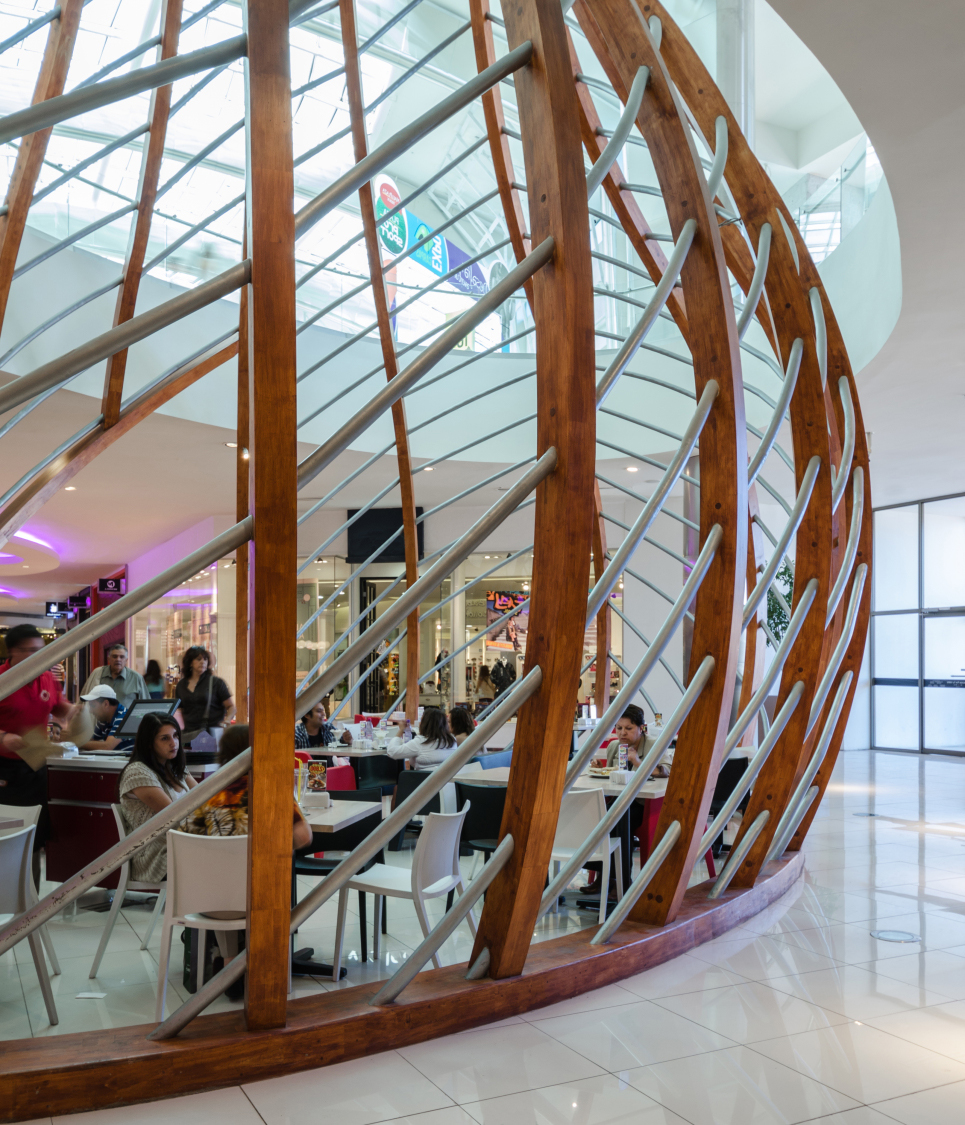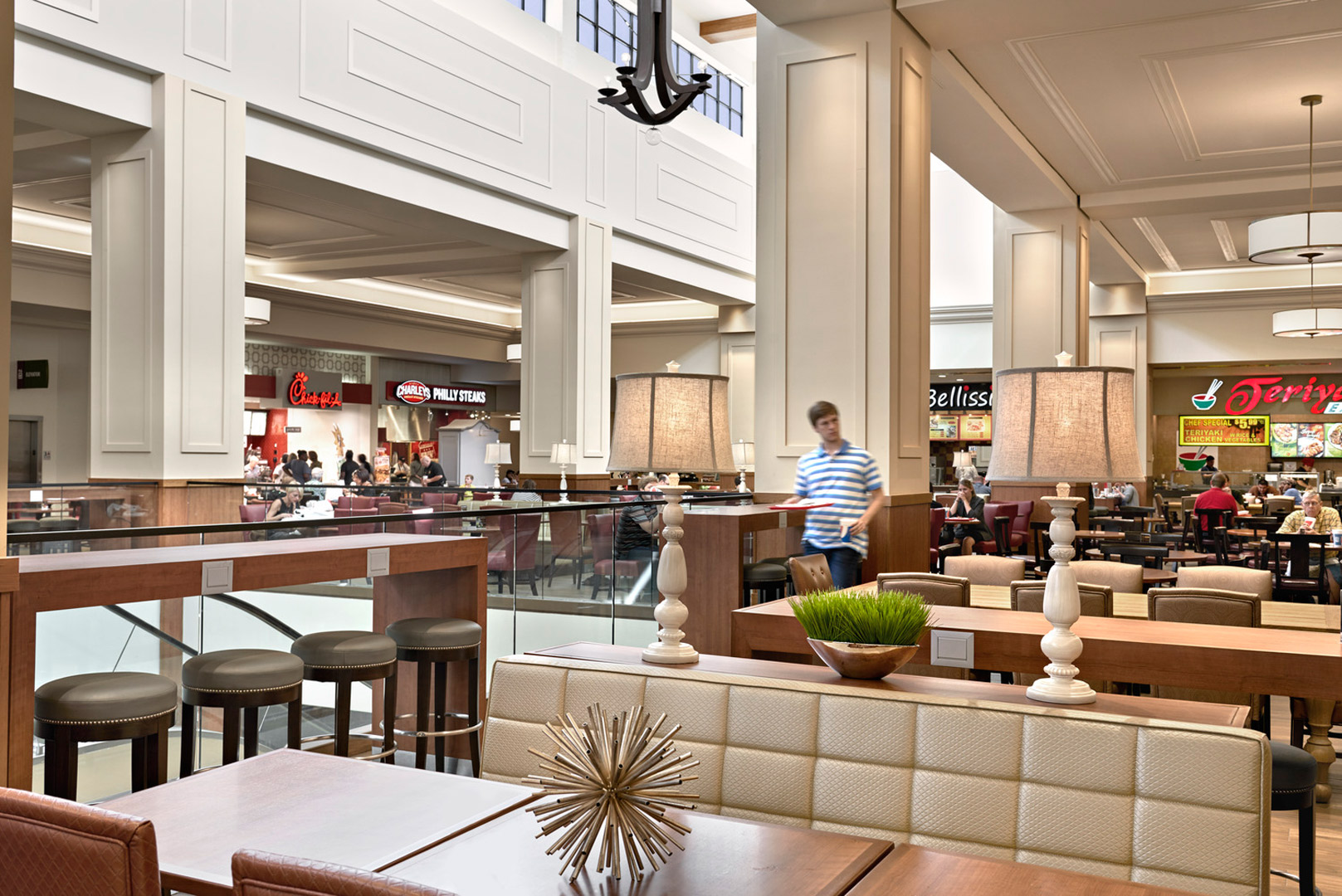In this highly competitive retailing world, one point of differentiation that remains largely untapped is the traditional common area. These frequently overlooked spaces represent opportunity, observers say. “Developers are definitely looking at ways to make a difference and be different, not relying so much on the anchors to draw you down through the mall,” said Donna Childs, a principal at Tvsdesign, an Atlanta-based architectural and interior design firm. “Lackluster at best” is the way Childs describes most of today’s common areas. “You have cart, cart, kiosk; cart, cart, kiosk,” she said. “Then, to top it off, they put a seating group only where you can’t put anything else. It’s not choreographed very well for that guest experience.”

Uncommon areas Sculptured restaurant seating replaced an open common area in Mall Plaza Trébol, in Concepción, Chile
Thus, perhaps it could be said that many a mall owner is putting both kiosk and cart before the horse, as it were. “What if we started with designing the spaces for people to linger and to have an experience first?” suggested Paula Carr Wideman, a Tvsdesign senior associate.
Architects recognize that return on investment is critical, however, and capturing sponsorships is a key to doing that and to improving the customer experience, says Childs. “Sponsorships are a great example of something that retail really hasn’t taken advantage of, and it’s where you’re entertaining and introducing a customer to a brand and saturating them in the brand experience,” said Childs.
The Tvsdesign team designed the hospitality area at the $1.6 billion Mercedes-Benz Stadium, in downtown Atlanta. “When people are in a public venue like that and they are there to be entertained, they really stop and they enjoy spaces along the way, and then that draws an even bigger crowd,” said Childs. “Why can’t we do something similar in shopping centers, because people are craving that destination where they can be entertained?”
Childs cites the hypothetical example of a university located near a mall. “A lot of people go there [to the mall] to study, so wouldn’t it make a lot of sense for that university to have something in the common area where people could go and plug in their laptops — and [where there could be] a monitor that shows an infomercial on the university, along with showcasing other things, like the football game, from Friday night or Saturday?”

Home away from home Brookwood Village mall, in Birmingham, Ala., was designed to resemble a home interior
Some international venues offer imaginative uses of the common area. Mall Plaza Oeste, in Santiago, Chile, won an ICSC Gold VIVA Award this year, thanks in part to its conversion of a parking lot into a lake. “It created both an indoor and exterior entertainment venue, and it absolutely changed the dynamics of the shopping environment,” said Childs.
Such creative reuses may be seen here at home too. Tvsdesign designed the upscale, 70,000-square-foot Brookwood Village mall, in Birmingham, Ala., to resemble a Birmingham resident’s home. “The food court doesn’t feel like a food court anymore — it feels like a dining room,” said Childs. “Seating areas feel like living rooms, not just like little leftover spaces.”
Mall landlord CBL Properties keeps common areas exciting with a pop-up concept that swaps out merchandise weekly to keep customers coming back, President and CEO Stephen D. Lebovitz said on an earnings call. “That’s been very successful for us in terms of bringing in new users and also bringing in customers.”
With multiple channels in competition for shoppers’ attention, Lebovitz says, it is important that centers offer customers a fresh experience each time they visit. “Pop-up stores are not a new thing, and we have a very successful seasonal business built around these short-term leases, but we’ve taken a new approach to this established idea,” Lebovitz said. “The pop-up provides an opportunity for local and online boutiques to showcase their merchandise.”
“The food court doesn’t feel like a food court anymore — it feels like a dining room. Seating areas feel like living rooms, not just like little leftover spaces.”
Another trend is locating full-service restaurants in common areas. “Very few malls in the U.S. have figured out how to do this, but in other countries, it is the norm,” said Childs. “What does it do to the center? All of a sudden you’ve got people in the middle of your mall, just like in a hotel lobby, and that’s a great thing — your vibe creates more people wanting to be there.”
Ultimately, making common areas more successful in the future requires fresh thinking, with the next generation of customers in mind, suggests Childs. “I think developers need to stop and think how we are going to attract this next generation into our centers,” said Childs. “It’s not by putting in another store; it’s trying to create a meaningful environment and venues that will attract this group of people to come and then come again. So it can’t be static — it’s got to be forever changing.”
By Ben Johnson
Contributor, Commerce + Communities Today


